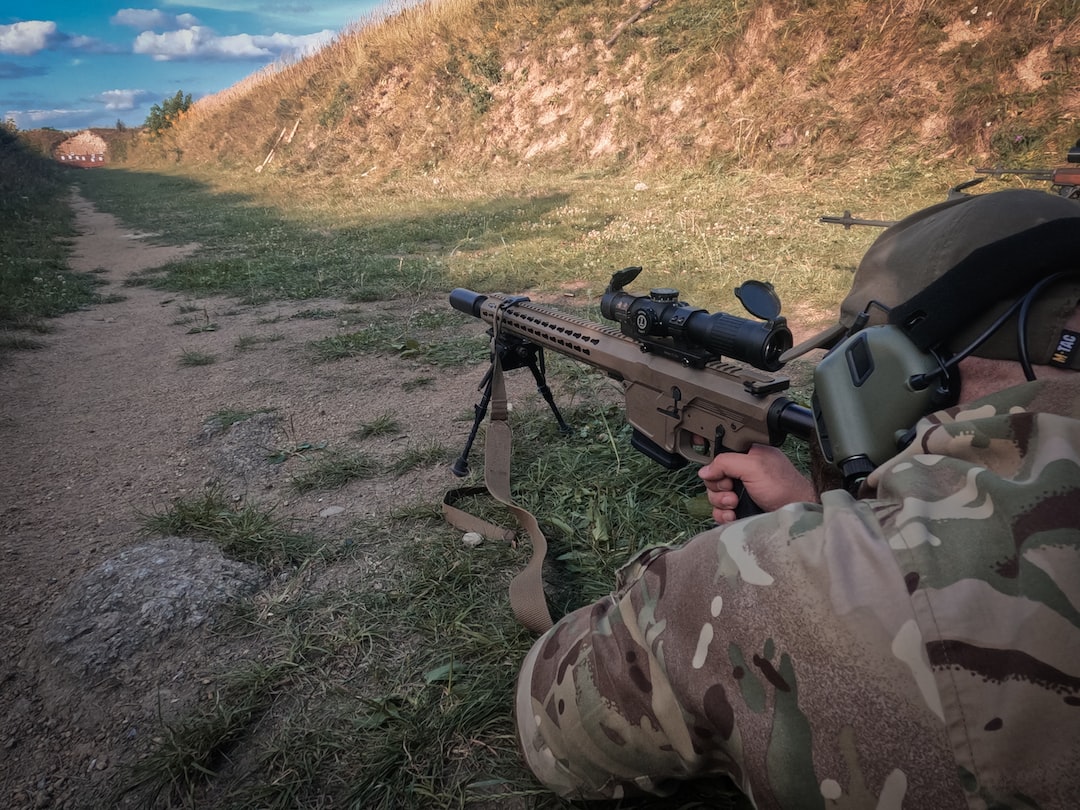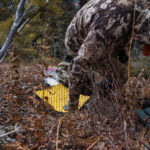Are you a hunter looking to take your shooting game up a notch?
Do you want to know more about rifle bi-pods and why they are important for hunting? Well, look no further.
Whether it’s shooting prone, kneeling or standing, having the right bipod can make all the difference. We’ll cover what is a rifle bi pod, how to choose one that fits your needs best, as well as advantages of quick detach and lightweight ones.
So if you’re seeking knowledge on this indispensable firearm accessory, peruse onward and prepare to be enlightened!
What is a Rifle Bipod?
A rifle bipod is a device that attaches to the front of a firearm and provides stability when shooting. It consists of two legs, which can be adjusted in length, and either clamps or mounts onto the gun’s barrel or stock.
Bipods are used by hunters, sportsmen, military personnel, and target shooters to improve accuracy while aiming at stationary targets from a prone position.
Definition of a Rifle Bipod:
A rifle bipod is an accessory designed to provide additional support for firearms when shooting from the prone position. It consists of two adjustable legs that attach to either the barrel or stock of the weapon via clamps or mounts. The legs can be adjusted in length depending on terrain conditions and shooter preference.
There are several varieties of rifle bipods available, including folding models with quick-release mechanisms, fixed models, swivel models with panning capabilities, telescoping models with adjustable height settings and tripod designs for increased stability over uneven ground surfaces.
Using a rifle bipod helps reduce fatigue during long periods spent shooting as it takes some weight off your arms while providing extra support for your hunting rifle’s barrel/stock assembly. Additionally, using one will help you maintain better control over your weapon when firing at longer distances as it reduces recoil significantly compared to freehand shooting techniques.
Finally, they also make it easier to take aim quickly without having to worry about wobbling around due to unsteady hands caused by fatigue or other factors such as wind gusts affecting your shot placement accuracy.
A rifle bipod is a great way to improve your shooting accuracy and stability, and with the right considerations in mind when choosing one, you can find the perfect fit for your needs. Let’s explore how to choose the right rifle bipod for you.
How to Choose the Right Rifle Bipod for You
When it comes to selecting the ideal rifle bipod, there are a few elements that ought to be taken into consideration. The first is what type of shooting will you be doing?
If you’re going to be hunting in rugged terrain or from elevated positions, then a heavier duty bipod with more adjustability may be best. On the other hand, if you’ll mostly be shooting from flat ground and don’t need as much adjustability, then a lighter weight model might suit your needs better.
The next consideration when selecting a rifle bipod is size and weight. Larger models tend to offer more stability but can also add extra bulk and weight to your firearm setup which can make carrying it around difficult.
Smaller models are usually lighter but may not provide as much stability as larger ones do. It’s essential to discover the equilibrium between mass and steadiness that is most suitable for you.
Finally, consider features such as adjustable legs, quick detach mechanisms, leg locks or tensioners and even rubber feet for added grip on slick surfaces like rocks or snow-covered ground.
Popular brands of rifle bipods include Harris Engineering Inc., Atlas Bipods by Accu-Shot Precision Products LLC., Caldwell Shooting Supplies and Versa Pod USA LLC When shopping for one of these products look at things like construction materials (aluminum vs steel), how easily they fold up/down (for storage)and any special features they may have such as swivel heads or adjustable legs/feet etc.
Overall, when selecting the right rifle bipod for yourself, take into account what type of shooting you will primarily use it for along with its size and weight characteristics plus any additional features that could come in handy while out in the field.
Choosing the right rifle bipod for you can be a daunting task, but with the right considerations and knowledge of popular brands and models, as well as features to look for in quality products, you will be able to make an informed decision.
Now that you have the necessary information to pick your ideal rifle bipod, let’s delve into shooting with it.
Shooting with a Rifle Bipod
Shooting with a Rifle Bipod is an important skill for any hunter or outdoors enthusiast. A rifle bipod is a two-legged support system that attaches to the front of your rifle and helps you stabilize it while shooting.
It can be used in either the prone, kneeling, or standing position.
Prone Position Shooting with a Rifle Bipod:
Prone position shooting is one of the most stable positions for firing your weapon accurately. When using a rifle bipod in this position, you should make sure that both legs are firmly planted on the ground and that they are spread apart at least shoulder width apart.
This will help ensure stability when taking aim and firing off shots. Additionally, make sure to use sandbags or other supports if available as these can provide additional stability when shooting from this position. This is a good setup to sight in your rifle.
Kneeling down behind your gun provides more mobility than lying flat on the ground, yet still offers a degree of stability when aiming and firing off shots. When using a rifle bipod in this position, it is important to keep both feet firmly planted on the ground and spread out slightly wider than shoulder width apart for good balance while taking aim and shooting accurately from this kneeling stance.
Additionally, avoid leaning too far forward as doing so can lead to instability which may impact accuracy when shooting from this position as well as cause fatigue over time due to having to hold yourself up against gravity for extended periods of time while hunting or target practicing from this stance.
Shooting with a Rifle Bipod is an essential skill for any hunter or sportsman. A bipod provides stability and accuracy when shooting from a prone, kneeling, or standing position. Realizing the nuances between shooting stances is key to optimizing your rifle’s potential and bettering outcomes in the wild.
Prone Position Shooting with a Rifle Bipod:
The prone position is one of the most stable shooting positions available. When using a bipod while in this position, you should ensure that both legs are firmly planted on either side of the rifle stock so that it remains steady during firing.
Furthermore, ensure your elbows are tucked snugly against your body to furnish the rifle with more stability and mitigate recoil after shooting. You will probably need to remove your bino harness which can slow you down in the field as you hurry to get a shot off.
Kneeling can be an effective alternative to shooting from the prone position if you don’t have enough room to lay down flat on your stomach or need more mobility than what laying down allows for. When using a bipod while kneeling, it is important to ensure that one leg is placed forward and the other back in order to form an “L” shape around the gunstock; this will help keep it steady when aiming at distant targets.
Additionally, make sure not to lean too heavily against either leg as doing so could cause instability due to recoil forces being transferred through them instead of directly into your body like when shooting from prone does naturally occur without extra effort needed by shooter himself/herself.
Standing Position Shooting with a Rifle Bipod:
Standing is usually reserved for close range targets since it offers less stability than other positions do but can still be used effectively if done correctly.
To shoot accurately from this stance, use two points of contact – such as both hands gripping onto either side of gunstock – along with keeping feet shoulder width apart (or wider) which will give you better balance overall during firing process itself.
Additionally, make sure that you’re leaning slightly forward towards target area before pulling the trigger; otherwise, the shot might go off-target due to incorrect weight distribution within body frame itself leading up to the moment right before the actual bullet leaves the barrel.
Using a rifle bipod can help improve accuracy and stability while shooting, providing an advantage in hunting situations. By utilizing a quick detach bi pod, you can enjoy the benefits of improved accuracy and increased convenience when switching positions.
Advantages of Using a Quick Detach Bi Pod for Hunting
What is Quick Detach Bi Pod? A quick detach bipod is a type of shooting support that can be quickly and easily attached to the rifle. A bipod with adjustable leg length, permitting the rifle to be raised or lowered for improved precision, is a quick detach bi-pod.
The quick detach feature of the bipod allows for effortless connection and disconnection from your hunting rifle, without requiring any tools.
Using a quick detach bi pod for hunting offers numerous advantages such as improved accuracy, convenience and comfort.
However, when choosing the right bi pod for your needs, it is important to consider the weight of the model in order to maximize its effectiveness while out on a hunt. Let’s take a look at why lightweight bi pods are so important for hunting success.
Why Are Lightweight Bi Pods Important for Hunting?
Lightweight bi pods are an important piece of equipment for hunters, as they provide stability and accuracy when shooting. A lightweight bipod is a device that attaches to the bottom of a rifle or other long gun and provides support while aiming.
The utilization of a lightweight bipod can bring forth great advantages – its like having a portable shooting rest wherever you go. Additionally, because they are lighter than traditional bipods, they can be easily transported in hunting packs or backpacks.
When choosing a lightweight bi pod for hunting purposes, there are several factors to consider such as weight capacity, adjustability and durability.
Weight capacity refers to how much weight the bi pod can hold before it starts sagging or bending under pressure; this will depend on what type of rifle you’re using and how heavy it is.
Adjustability refers to how far out you can extend the legs; some models offer telescoping legs which allow you to customize your shooting position more precisely than with fixed-length models.
Durability should also be taken into account since these devices will be exposed to harsh weather conditions while out in the field; look for ones made from high-quality materials like aluminum alloy or carbon fiber which won’t corrode over time due to exposure moisture or extreme temperatures.
Popular brands and models of lightweight bi pods include:
- Harris Engineering Bipods (which come in both 6 inch and 9 inch sizes),
- Caldwell XLA Bipods (available in 8 inch – 13 inch lengths) and
- Magpul Industries Hunter X22 Bipods (with adjustable leg extensions).
All three brands offer quality construction at reasonable prices so no matter what kind of budget you have there should be something available that fits your needs perfectly.
In conclusion, if you are looking for increased accuracy when hunting then investing in a good quality lightweight bipod could make all the difference between success and failure.
With their improved portability compared to heavier models plus added features like adjustable leg extensions, these devices are sure to help improve your aim while out on hunts.
FAQs in Relation to Rifle Bi Pod
Should you put a bipod on a hunting rifle?
The verdict on whether to mount a bipod onto one’s hunting rifle is ultimately in the hands of each individual hunter, left for them to determine. Bipods can be beneficial in providing stability and accuracy when shooting from a prone position, but they also add extra weight and bulk to your rifle which may make it more difficult to carry for longer hunts.
Additionally, some hunters prefer the freedom of movement that comes with shooting without a bipod. Ultimately, each hunter must decide if the benefits of using a bipod outweigh any potential drawbacks for their particular situation.
What bipod do army snipers use?
The Army uses a variety of bipods for its snipers, depending on the mission and environment. The Harris Engineering S-BRM Bipod is the most commonly used by Army snipers due to its lightweight design and adjustable legs. It features an adjustable tension control knob which allows for fine tuning of the panning and canting motion, making it ideal for precision shooting in any terrain or weather conditions.
Additionally, it has a spring loaded folding mechanism that makes transitioning from transport to shooting quick and easy. This versatile bipod provides superior stability when firing from prone positions or other awkward angles, making it an invaluable tool for military snipers around the world.
What is the best rifle bipod height?
The best rifle bipod height depends on the shooter’s individual needs and preferences. Generally, a bipod should be set at a height that allows for comfortable shooting from any position while still providing enough stability to ensure accuracy.
The optimal height of the bipod will fluctuate contingent upon the kind of landscape being hunted, the stature of the shooter, and other elements such as windy weather. In the end, each hunter needs to decide what will be most effective for them in order to have optimal results while hunting.
Are swagger bipods worth it?
Swagger bipods are worth it for hunters who need a reliable and adjustable shooting platform. They offer superior stability, allowing you to take more accurate shots from any terrain. The quick-deployment design makes them easy to set up and break down in seconds, while the lightweight construction ensures they won’t weigh you down on long treks.
Swagger bipods are a little heavy and bulky and might not fit with a rifle cover, depending on the model.
Swagger bipods come with a guarantee of lifetime durability, giving you assurance that your purchase will stand the test of time.
Conclusion
Using a rifle bi pod is an essential part of hunting and should not be overlooked. It allows you to take accurate shots from different positions, such as prone, kneeling or standing. When choosing the right rifle bi pod for your needs, consider factors like shooting position, weight and quick detach features.
Lightweight bipods are especially important when hunting in remote areas since they can easily be carried around without compromising on accuracy or stability. With all these advantages in mind, it’s clear that investing in a quality rifle bi-pod is worth every penny.



